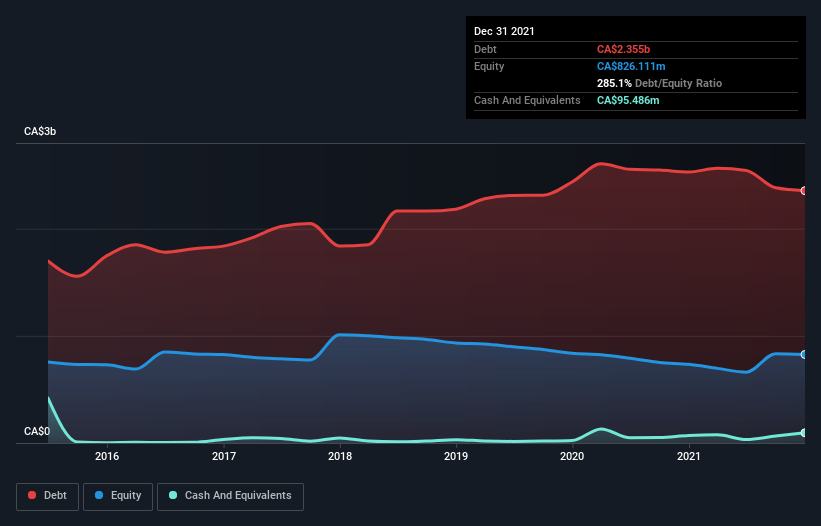- Canada
- /
- Healthcare Services
- /
- TSX:CSH.UN
Chartwell Retirement Residences (TSE:CSH.UN) Takes On Some Risk With Its Use Of Debt
Legendary fund manager Li Lu (who Charlie Munger backed) once said, 'The biggest investment risk is not the volatility of prices, but whether you will suffer a permanent loss of capital.' It's only natural to consider a company's balance sheet when you examine how risky it is, since debt is often involved when a business collapses. We can see that Chartwell Retirement Residences (TSE:CSH.UN) does use debt in its business. But the more important question is: how much risk is that debt creating?
When Is Debt Dangerous?
Debt assists a business until the business has trouble paying it off, either with new capital or with free cash flow. Ultimately, if the company can't fulfill its legal obligations to repay debt, shareholders could walk away with nothing. However, a more frequent (but still costly) occurrence is where a company must issue shares at bargain-basement prices, permanently diluting shareholders, just to shore up its balance sheet. Of course, debt can be an important tool in businesses, particularly capital heavy businesses. When we think about a company's use of debt, we first look at cash and debt together.
View our latest analysis for Chartwell Retirement Residences
How Much Debt Does Chartwell Retirement Residences Carry?
The image below, which you can click on for greater detail, shows that Chartwell Retirement Residences had debt of CA$2.36b at the end of December 2021, a reduction from CA$2.53b over a year. However, because it has a cash reserve of CA$95.5m, its net debt is less, at about CA$2.26b.

How Strong Is Chartwell Retirement Residences' Balance Sheet?
Zooming in on the latest balance sheet data, we can see that Chartwell Retirement Residences had liabilities of CA$509.4m due within 12 months and liabilities of CA$2.08b due beyond that. On the other hand, it had cash of CA$95.5m and CA$25.4m worth of receivables due within a year. So its liabilities total CA$2.47b more than the combination of its cash and short-term receivables.
This deficit is considerable relative to its market capitalization of CA$3.08b, so it does suggest shareholders should keep an eye on Chartwell Retirement Residences' use of debt. Should its lenders demand that it shore up the balance sheet, shareholders would likely face severe dilution.
In order to size up a company's debt relative to its earnings, we calculate its net debt divided by its earnings before interest, tax, depreciation, and amortization (EBITDA) and its earnings before interest and tax (EBIT) divided by its interest expense (its interest cover). This way, we consider both the absolute quantum of the debt, as well as the interest rates paid on it.
Chartwell Retirement Residences shareholders face the double whammy of a high net debt to EBITDA ratio (10.7), and fairly weak interest coverage, since EBIT is just 0.62 times the interest expense. This means we'd consider it to have a heavy debt load. Worse, Chartwell Retirement Residences's EBIT was down 37% over the last year. If earnings keep going like that over the long term, it has a snowball's chance in hell of paying off that debt. There's no doubt that we learn most about debt from the balance sheet. But it is future earnings, more than anything, that will determine Chartwell Retirement Residences's ability to maintain a healthy balance sheet going forward. So if you're focused on the future you can check out this free report showing analyst profit forecasts.
Finally, while the tax-man may adore accounting profits, lenders only accept cold hard cash. So we clearly need to look at whether that EBIT is leading to corresponding free cash flow. Over the last three years, Chartwell Retirement Residences actually produced more free cash flow than EBIT. That sort of strong cash generation warms our hearts like a puppy in a bumblebee suit.
Our View
On the face of it, Chartwell Retirement Residences's interest cover left us tentative about the stock, and its EBIT growth rate was no more enticing than the one empty restaurant on the busiest night of the year. But at least it's pretty decent at converting EBIT to free cash flow; that's encouraging. We should also note that Healthcare industry companies like Chartwell Retirement Residences commonly do use debt without problems. Overall, we think it's fair to say that Chartwell Retirement Residences has enough debt that there are some real risks around the balance sheet. If everything goes well that may pay off but the downside of this debt is a greater risk of permanent losses. The balance sheet is clearly the area to focus on when you are analysing debt. However, not all investment risk resides within the balance sheet - far from it. Be aware that Chartwell Retirement Residences is showing 4 warning signs in our investment analysis , and 2 of those don't sit too well with us...
If you're interested in investing in businesses that can grow profits without the burden of debt, then check out this free list of growing businesses that have net cash on the balance sheet.
New: AI Stock Screener & Alerts
Our new AI Stock Screener scans the market every day to uncover opportunities.
• Dividend Powerhouses (3%+ Yield)
• Undervalued Small Caps with Insider Buying
• High growth Tech and AI Companies
Or build your own from over 50 metrics.
Have feedback on this article? Concerned about the content? Get in touch with us directly. Alternatively, email editorial-team (at) simplywallst.com.
This article by Simply Wall St is general in nature. We provide commentary based on historical data and analyst forecasts only using an unbiased methodology and our articles are not intended to be financial advice. It does not constitute a recommendation to buy or sell any stock, and does not take account of your objectives, or your financial situation. We aim to bring you long-term focused analysis driven by fundamental data. Note that our analysis may not factor in the latest price-sensitive company announcements or qualitative material. Simply Wall St has no position in any stocks mentioned.
About TSX:CSH.UN
Chartwell Retirement Residences
Chartwell is in the business of serving and caring for Canada's seniors, committed to its vision of Making People's Lives BETTER and to providing a happier, healthier, and more fulfilling life experience for its residents.
Average dividend payer with moderate growth potential.
Market Insights
Community Narratives



